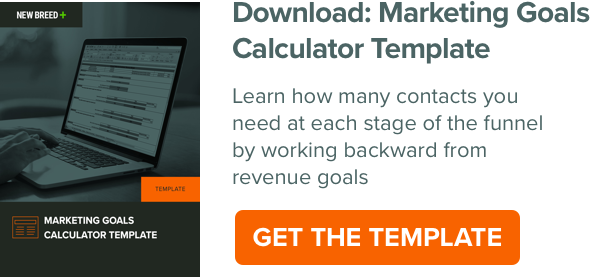How to Lower Your Customer Acquisition Cost (CAC)

If you're in marketing or sales, you know how important it is to bring in new business. In fact, 63 percent of marketers agree that new customer acquisition is the most important advertising goal, and companies are known to focus on acquisition more than on customer retention — though the former can cost seven times more than the latter, according to Kissmetrics.
But both are important, and you can't only rely on your current customers for the bulk of your revenue, despite retention cost being significantly lower than acquisition cost, in general. So, how can you lower your customer acquisition cost?
Start with learning how to measure it.
A New Take on Measuring Customer Acquisition Cost
InsightSquared has some good advice for VC firms about keeping measurement simple: "To determine the marketing CAC, add up all of your portfolio company’s expenses — salaries, overhead, program spend, etc. — over a given time period and divide by the total number of new customers generated by Marketing."
But the simple way is not the only way to measure CAC, and you should focus on following industry best practices when it comes to measuring your own. Companies in your industry may exclude all fringe costs, for example, or measure by campaign type or channel and then create an overall cost that reflects the contribution of each in order to better understand where to focus marketing energy.
And finally, you need to consider the relationship between lifetime value and CAC. Customer acquisition cost, on its own, doesn't mean much. If you have a CAC of $10 but a lifetime value (LTV) of $1,000, that's a heck of a lot better than a CAC of $5 for a lifetime value of $100. Put your CAC in context so you can better decide how important it is to lower it, and by how much. David Skok writes that the desired relationship is an LTV at least three times your CAC. If you don't meet the mark, "you should revisit your model and look for ways to a) raise your prices and/or b) reduce your costs."
Let's tackle costs first.
It's Time to Get Low
With your CAC measured accurately in keeping with industry best practices, you're ready to start executing a plan for lowering it. These five tips should help.
1. Focus your buyer profiles
Both Skok (in his OpenView post) and Neil Patel, writing for Entrepreneur, agree with us on this one. Get your personas right and you won't waste time, energy and money trying to market or sell where you don't really belong. Finding the right channels and the right message for your ideal customer is a surefire way to lower costs.
2. "Buy in" to SEO
We're not suggesting you start a paid search campaign just to lower CAC. We are suggesting you "buy in" to SEO through creating highly targeted, long tail keywords based on your personas and building content that responds to and includes those keywords, so you can keep raking in organic traffic over time without any extra spend.
Get the prospect into a nurturing stream and you'll lower cost. How? Acquisition cost is directly related to how many touches a salesperson has with a lead — more time spent = more hours paid = increasing CAC. If your marketing team nurtured a lead (marketers can work multiple leads at once) until that lead was truly qualified as an MQL and ready to move to an opportunity, your cost will remain lower than if you were to employ a strategy where sales grabs up an unqualified lead and continually works it.
3. Implement a marketing automation platform
If you haven't done this already, you're missing out on major opportunity to cut out the hours you and your employees spend capturing and organizing information, segmenting your contacts, creating CTAs, scheduling email sends...you name it.
The right automation platform will be a full-funnel solution where you can easily view contact records/activity and the data that represent the success of your campaigns. According to Gartner, companies that automate lead management see a 10 percent or greater increase in revenue in six to nine months. Increased revenue means lower CAC.
4. Adapt your whole technology stack
Let's be real: When it comes to data, you're probably going to need more than just a marketing automation platform to help you understand your pipeline and manage it well. You need a contact database that integrates with your marketing automation platform, and you likely need an analytics platform that integrates with both — that is, if you really want to gain insight into your pipeline. We're big fans of InsightSquared.
5. Develop a nurture strategy and execute via email
According to BtoB magazine, marketers still love email — and they have their reasons.
- 49% of B2B marketers spend more time and resources on email than on other channels
- 59% of B2B marketers say email is the most effective channel for generating revenue
Now let's say you've taken the first few tips in this post seriously, and you now have a marketing automation platform that lets you view contact records, email content to lists, and create workflows for each contact based on their actions. You're in an excellent position to design a nurture strategy that will help you turn prospects into leads. And what is the best way to disseminate the content within that strategy? Email, of course! For one thing, sending an email costs next to nothing (aside from your overhead for employees to build and schedule the email).
And another benefit: Companies that excel at lead nurturing generate 50 percent more sales-ready leads at 33 percent lower cost, according to Forrester Research. Through using email to nurture your prospects, you can pass your sales reps truly qualified leads for that one-to-one conversation, effectively shortening the sales cycle.
What else can you do to lower CAC?
From list purchases to extensive A/B testing, there are a million tactics you can employ to lower your customer acquisition cost and see the returns, so we don't suggest using this as your exhaustive list. But it is a great place to start.
Guido Bartolacci
Guido is Head of Product and Growth Strategy for New Breed. He specializes in running in-depth demand generation programs internally while assisting account managers in running them for our clients.




